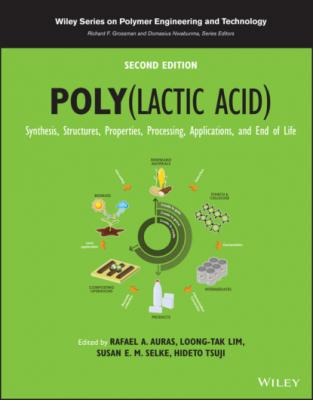Poly(lactic acid). Группа авторов
Чтение книги онлайн.
Читать онлайн книгу Poly(lactic acid) - Группа авторов страница 83
 various L/R ratios, and (b) a series of PLLA/PDLA blend samples before and after annealing. The crystalline band at 1306 cm−1 shows a clear change of ΔAbs depending on the L/R ratio.
various L/R ratios, and (b) a series of PLLA/PDLA blend samples before and after annealing. The crystalline band at 1306 cm−1 shows a clear change of ΔAbs depending on the L/R ratio.
Source: Reproduced from Tashiro et al., Macromolecules 2017, 50, 8066−8071.
Figure 6.22 illustrates the formation process of the stereocomplex crystal region in the amorphous film containing the random distribution of L and D (or R) chains. The domains of only L or D components and the region of randomly mixed L and D components are coexistent. These amorphous domains composed of only D or L components crystallize partially into the δ (or α) form, when the film is heated above the glass transition temperature. At a higher temperature, the α crystallites are melted. In the cooling process, these molten chains are aggregated to form the crystalline region of the stereocomplex. It is hard to imagine that they change drastically their spatial distribution to create the structure consisting of the regularly‐ and alternately‐packed R and L chain components. It is more natural to consider that the heterogeneously distributed PDLA and PLLA chains co‐crystallize together without large change of their spatial arrangements.
FIGURE 6.22 A model of stereocomplex formation from the solution cast L/D blend sample. Here “D” is equivalent to “R.”
Source: Reproduced from Tashiro et al., Macromolecules 2017, 50, 8048−8065.
6.6 PHB AND OTHER BIODEGRADABLE POLYESTERS
In addition to PLA, several aliphatic polyesters are becoming good targets for biodegradable and carbon‐neutral multipurpose polymers, though they do not have necessarily the asymmetric carbon atoms on the skeletal chains. Because of the relatively high biodegradability, these various polyesters have become increasingly important in commodity field, including medical and pharmaceutical applications, food packaging, and even automobiles. To understand and improve their physical properties, it is needed to know how the combination between the ester parts and the aliphatic (and aromatic) segments affects the structure, phase transition, and crystallization behaviors in the different manner from those of the above‐mentioned PLA case. In this section, several representative aliphatic polyesters are listed, and their structural characteristics are briefly described.
6.6.1 Poly(3‐Hydroxybutyrate) (PHB)
6.6.1.1 Crystal Structure of α Form
PHB crystallizes usually as the α form. The orthorhombic unit cell parameters are a = 5.76 Å, b = 13.20 Å, and c (chain axis) = 5.96 Å, in which the two 2/1 helical chains of TTGG conformation are packed with the P212121 space group symmetry [79]. Figure 6.23 shows the crystal structure of the α form [80, 81]. In the IR spectra of the α form, the anti‐symmetric CH stretching mode of CH3 groups [ν as(CH)] was found to appear at appreciably high frequency side, 3009 cm−1, which was interpreted as a result of the intermolecular CH3…O(═C) interactions between the neighboring chains coming from the anomalously short H…O distance (2.62 Å) [80, 82].
FIGURE 6.23 (a) Chain conformation and (b) chain packing mode obtained for the PHB α and β forms.
Source: Reproduced from Phongtamrug and Tashiro, Macromolecules 2019, 52, 2995–3009 and Wang and Tashiro, Macromolecules 2016, 49, 581–594.
6.6.1.2 Crystal Structure of β Form
The PHB β form is produced by strongly stretching an oriented α form sample [83]. It is actually impossible to obtain the pure β sample even when the sample is stretched up to the occurrence of fracture. Therefore, the observed X‐ray diffraction pattern contains necessarily the two patterns of the α and β forms. Figure 6.24b shows the X‐ray diffraction pattern of the pure β component, which was obtained by subtracting the diffraction pattern of the pure α form from the original pattern [81]. The equatorial line consists of the highly oriented spots, while the layer lines are quite diffuse. The unit cell parameters were determined as a = b = 9.22 Å, c (chain axis) = 4.66 Å and γ = 120°. The repeating period 4.66 Å corresponds to the almost extended chain conformation (see Figure 6.23a). After the many trial‐and‐error processes, the structure model of the space group P3221 was found to reproduce the observe diffraction profiles along all the layer lines reasonably. Figure 6.23b shows the thus‐obtained crystal structure of the β form. The upward and downward chains are located at one lattice site at 50% probability. Figure 6.24c compares the observed diffraction profiles with those calculated for this model.
At this stage, we can compare the chain conformations of the various crystalline forms of PLA and PHB as follows. Roughly speaking, PLA takes the TTG chain conformation, though the T and G values vary slightly among the different crystal forms (α, δ, and β forms). On the other hand, the PHB α form takes the conformation of TTGG sequences, but the positions of these torsional angles are different from those of PLA chain although the local chemical structure is similar to each other. Besides, the strong stretching of the PHB chains causes the large change of the torsional angle from G to T. The rough comparison of the torsional angles is made as shown below, where T ≈ 160–180°, T′ ≈ 150–160°, and G ≈ 50–80°.
FIGURE 6.24 The 2D X‐ray diffraction patterns of PHB. (a) The mixture of the α and β forms, (b) the β form pattern obtained by the subtraction of the X‐ray pattern of the pure α form from (a). (c) Comparison of the X‐ray diffraction profiles along the various layer lines observed for PHB β form with those calculated for the model with the space group P3221.
Source: Reproduced from Phongtamrug and Tashiro, Macromolecules 2019, 52, 2995–3009.
| PLA | …─C(CH3)─C(O)─O─C(CH3)─C(O)─O─C(CH3)─ |
| (α, δ, β) | T′ T G T′ T G |
| PHB | …─CH2─C(O)─O─C(CH3)─CH2─C(O)─O─C(CH3)─… |
| α | G G T T′ G G T T′ |